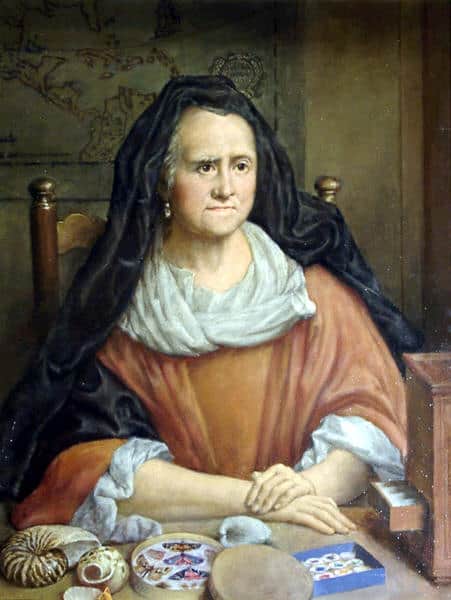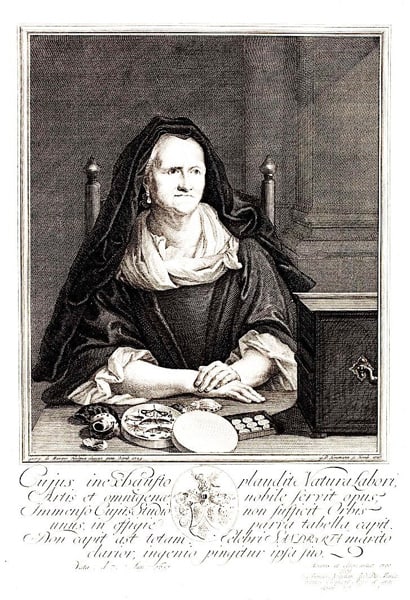DIFFERENT FACES AS PORTRAITS OF MARIA SIBYLLA MERIAN
Until a few years ago, even after 2010, most essays about Maria Sibylla Merian on the internet were illustrated with a colourful painting by "de Bâle". (1)
Thus far, it has not proved possible to identify this painter. His portrait is also listed on Wikisource, but with the added information that it portrays a completely different woman and the "collection is unknown". This picture is now hardly ever shown in connection with Merian.
Phantom of a painting on the Internet
It is easier to find the copper etching (2), which probably served as a model for the untraceable painter "de Bâle". The woman in question is Esther Barbara Sandrartin, née Bloemartin (1651-1733), wife of Joachim von Sandrart, the famous "Painter Prince" and author of the first encyclopaedia of artists for the German-speaking area.
On the lower, etched frame we find information on the draughtsman and painter of the model: “Georg de Marees 1725” (left), as well as the signature of the etcher: “G. D. Heumann 1727” (right).
In the Latin inscription below the portrait it can clearly be read that the husband of the lady in the image was the famous (Joachim von) Sandrart (1606-1688):
In fact her date of birth was etched on the copper plate: "Nata. d. 7. Jun. 1653". Confusion of the subject with Maria Sibylla Merian was, therefore, not really possible, but the print could enjoy better sales and at a higher price if it was presented as a depiction of M. S. Merian after the lower part with the inscription had been cut off.
Even with the correct identity, the etching remains valuable for research on Merian’s Nuremberg background: in those days, queens and princesses were indeed portrayed, but such a high-quality etching for a woman like Frau Sandrart was an unusual honour at that time and shows that other women, too, were actually respected personalities in Nuremberg around 1700.
Frau Sandrart was a very educated woman with a large collection of natural objects, a real “Cabinet of Curiosities”. Her even more famous husband had appointed her his universal heir. On the etching she is portrayed as an expert butterfly collector. She was only four years younger than Maria Sibylla Merian and probably one of her good customers.
A FRENCH PAINTER AS THE ALTER EGO OF M. S. MERIAN
Another, very astonishing "transfer of identity" happened with a painting by Jean Baptiste Santerre, which was painted during Merian's lifetime. The young, attractive woman sits model for the painter in a way that does not fit M. S. Merian at all. Even the painter's palette would be out of place with Merian, because she did not paint in oil but in watercolours.
CONFUSION WITH HER OLDER HALF-BROTHER JOACHIM
The wish of many admirers to imagine this extraordinary artist and naturalist as accurately as possible was “fulfilled” by a fictitious child portrait of Maria Sibylla, in the picture with Matthäus Merian the Elder (1583-1659) and his first wife Maria Magdalena (1598-1645) in the midst of their children. (1) The youngest son, Joachim (1635-1701), was presented as Maria Sibylla.
However, when the picture was painted, she was not yet born. In the lower right corner, it is not her we see, but her half-brother Joachim, older by twelve years, who hauls the enormous, imposing, antique plaster head into the picture. When he was ten years old, his mother died and his widowed father married his second wife Johanna Sibylla (1620-1690). One year later Maria Sibylla was born.










